
Mazda 2: Child-Restraint System Installation
Mazda2 Owners Manual
Categories of Child-Restraint Systems
NOTE
When purchasing, ask the manufacturer of the child-restraint system which type of childrestraint system is appropriate for your child and vehicle.
(Europe)
Child-restraint systems are classifi ed into the following 5 groups according to the UNECE 44 regulation.

(Other countries)
Please comply with the legal regulations concerning the use of child-restraint systems in your country.
Child-Restraint System Types
(Europe) In this owner's manual, explanation of child-restraint systems secured with seat belts is provided for the following three types of popular child-restraint systems: baby seat, child seat, junior seat.
NOTE
- Installation position is determined
by the type of child-restraint system.
Always read the manufacturer's instructions and this owner's manual carefully.
- Due to variations in the design of child-restraint systems, vehicle seats and seat belts, all child-restraint systems may not fi t all seating positions. Before purchasing a childrestraint system, it should be tested in the specifi c vehicle seating position (or positions) where it is intended to be used. If a previously purchased child-restraint system does not fi t, you may need to purchase a different one that will.
Baby seat
Equal to Group 0 and 0 of the UNECE 44 regulation.
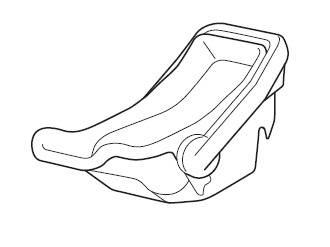
Child seat
Equal to Group 1 of the UNECE 44 regulation.
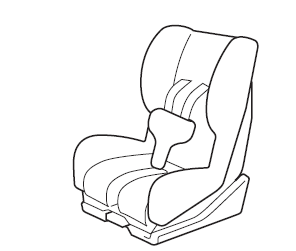
Junior seat
Equal to Group 2 and 3 of the UNECE 44 regulation.
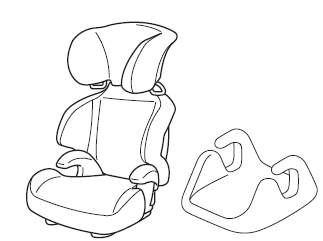
(Other countries)
Please comply with the legal regulations concerning the use of child-restraint systems in your country.
Baby Seat Installation Position
A baby seat is used in the rear-facing position only.
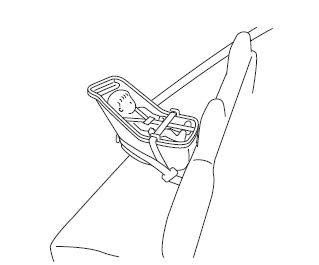
Refer to the table, “Child-Restraint System Suitability for Various Seat Positions” for baby seat installation position (page 2-32 ).
WARNING
Always install a baby seat in the correct seat position: Installing a baby seat without fi rst consulting the table “Child-Restraint System Suitability for Various Seat Positions” is dangerous. A baby seat installed on the wrong seat position cannot be properly secured. In a collision, the child could hit something or someone in the vehicle and be seriously injured or even killed.
WARNING
Never use a rear-facing child-restraint system on the front passenger seat protected by an air bag: NEVER use a rearward facing child restraint on a seat protected by an ACTIVE AIRBAG in front of it, DEATH or SERIOUS INJURY to the CHILD can occur.
The child-restraint system can be hit
by the deploying air bag and knocked
out of position. A child in the childrestraint
system could be seriously
injured or killed. If your vehicle is
equipped with a front passenger air
bag deactivation switch, always set the
switch to the OFF position if installing
a rear-facing child-restraint system on
the front passenger seat is unavoidable.
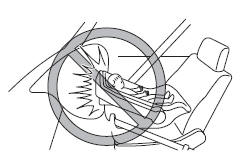
Child Seat Installation Position
A child seat is used in front-facing and rear-facing positions depending on the age and size of the child. When installing, follow the manufacturer's instructions in accordance with the appropriate age and size of the child as well as the directions for installing the child-restraint system.
Refer to the table, “Child-Restraint System Suitability for Various Seat Positions” for child seat installation position (page 2-32 ).
Rear-facing type
WARNING
Always install a front-facing child seat in the correct seat position: Installing a front-facing child seat without fi rst consulting the table “Child-Restraint System Suitability for Various Seat Positions” is dangerous. A front-facing child seat installed on the wrong seat position cannot be properly secured. In a collision, the child could hit something or someone in the vehicle and be seriously injured or even killed.
Never use a rear-facing child-restraint system on the front passenger seat protected by an air bag: NEVER use a rearward facing child restraint on a seat protected by an ACTIVE AIRBAG in front of it, DEATH or SERIOUS INJURY to the CHILD can occur.
The child-restraint system can be hit
by the deploying air bag and knocked
out of position. A child in the childrestraint
system could be seriously
injured or killed. If your vehicle is
equipped with a front passenger air
bag deactivation switch, always set the
switch to the OFF position if installing
a rear-facing child-restraint system on
the front passenger seat is unavoidable.
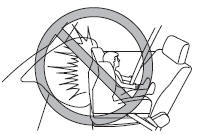
Front-facing type
WARNING
Never install a front-facing child seat in the wrong seat position: Installing a front-facing child seat without fi rst consulting the table “Child-Restraint System Suitability for Various Seat Positions” is dangerous. A front-facing child seat installed in the wrong seat position cannot be properly secured. In a collision, the child could hit something or someone in the vehicle and be seriously injured or even killed.
Do not install a front-facing childrestraint
system on the front passenger
seat unless it is unavoidable:
In a collision, the force of a deploying
air bag could cause serious injury or
death to the child. If installing a frontfacing
child-restraint system on the
front passenger seat is unavoidable,
move the front passenger seat as far
back as possible and make sure that the
front passenger air bag deactivation
switch is in the OFF position. Refer to
Front Passenger Air Bag Deactivation
Switch (page 2-46 ). 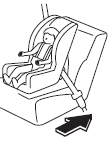
Junior Seat Installation Position
A junior seat is used in the front-facing position only.
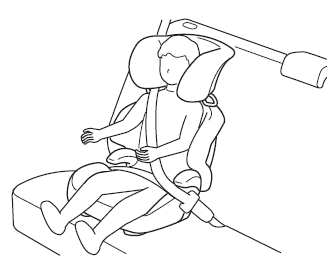
Refer to the table, “Child-Restraint System Suitability for Various Seat Positions” for junior seat installation position (page 2-32 ).
WARNING
Always install a junior seat in the correct seat position: Installing a junior seat without fi rst consulting the table “Child-Restraint System Suitability for Various Seat Positions” is dangerous. A junior seat installed on the wrong seat position cannot be properly secured. In a collision, the child could hit something or someone in the vehicle and be seriously injured or even killed.
WARNING
Do not install a front-facing childrestraint
system on the front passenger
seat unless it is unavoidable:
In a collision, the force of a deploying
air bag could cause serious injury or
death to the child. If installing a frontfacing
child-restraint system on the
front passenger seat is unavoidable,
move the front passenger seat as far
back as possible and make sure that the
front passenger air bag deactivation
switch is in the OFF position. Refer to
Front Passenger Air Bag Deactivation
Switch (page 2-46 ). 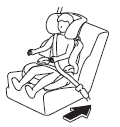
Other info:
Chevrolet Sonic. Jump Starting
For more information about the vehicle battery, see Battery.
If the battery has run down, try to use another vehicle and some jumper cables
to start your vehicle. Be sure to use the following steps ...
Honda Fit. Accessories
When installing accessories, check the following:
• Do not install accessories on the windshield. They can obstruct your view and
delay your reaction to driving conditions.
• Do not install acc ...
Honda Fit. Driving
Manual Transmission
Automatic Transmission
● Shift to P and depress the brake pedal when starting the engine.
Shifting
Park
Turn off or start the engine.
Transmission is locked.
R ...
Manuals For Car Models
-
 Chevrolet Sonic
Chevrolet Sonic -
 Citroen C3
Citroen C3 -
 Fiat Punto
Fiat Punto -
 Honda Fit
Honda Fit -
 Mazda 2
Mazda 2 -
 Nissan Micra
Nissan Micra -
 Peugeot 208
Peugeot 208 -
 Renault Clio
Renault Clio -
 Seat Ibiza
Seat Ibiza -
 Skoda Fabia
Skoda Fabia - Honda Pilot
- Volkswagen ID4
- Toyota Prius


